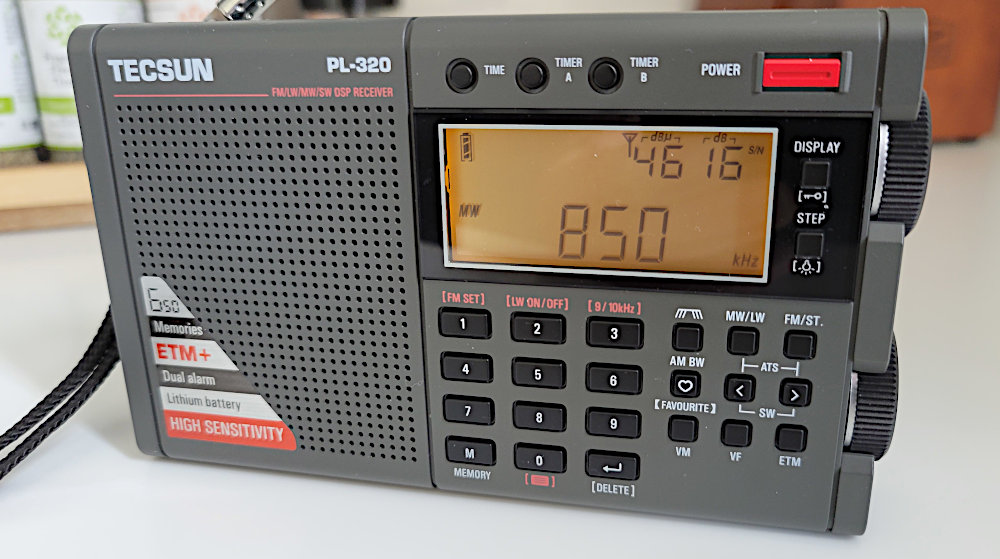
By 2020, the lineup of DSP-based radios from Chinese manufacturer Tecsun had not changed in several years, with venerable models such as the PL-310ET and PL-380 representing the first wave of DSP-based radios on the market. The next generation of DSP-based radios was already well underway in 2020 when Tecsun released the PL-330, which departed from previous designs in several ways. Most notably, the PL-330 used a lithium-ion rechargeable battery and offered single-sideband (SSB) reception.
SSB is most useful in shortwave bands, which I'm not particularly interested in. And I don't like lithium-ion batteries in radios. Evaluations of the PL-330's capabilities on AM and FM also varied, with one noted reviewer indicating that Tecsun's earlier models were better FM performers. There were also fewer bandwidth filters for AM stations compared to the earlier Tecsun models. So I passed on the PL-330.
Three years later, Tecsun released a new model without SSB capability, the PL-320. But Tecsun didn't just take out that capability; it also added some new and interesting features. The PL-320 looks very similar to the PL-330. This has led to some comments online that the PL-320 is just the PL-330 without SSB. But I don't think that's the case. As Radio Jay Allen points out, the PL-320 adds some features and capabilities of its own.
At first, the PL-320 was available only from Chinese resellers; I ordered one for around $80. It turned out that the reseller I used, anon-co, had started fulfilling orders from a facility in the Pacific Northwest. So I got the radio three days later, in a model clearly intended for an international market, with settings appropriate for North America. The user manual was in clear English.
The PL-320 began appearing on Amazon in mid-July, priced $10 less than the PL-330, and at a price comparable to that I paid to the Chinese reseller. I liked the radio enough to order another one!
Indeed, the PL-320 is a very likeable radio. Some of the annoyances from earlier Tecsun models have been fixed. For example, various noises generated by the internal digital circuitry of the PL-310ET or PL-380 could interfere with some AM signals. Those noises seem to be gone from the PL-320.
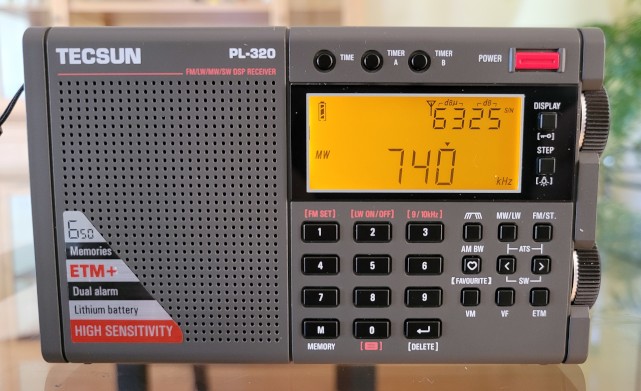
Another annoyance of earlier Tecsun models was the way tuning stepped between frequencies when using the tuning knob. Those radios would try to guess whether you wanted large steps (such as 10 kHz on AM and 100 kHz on FM) or small steps (1 kHz and 10 kHz respectively) based on the speed with which you turned the knob. Problem is, the radios often guessed wrong. There's no guessing with the PL-320. A STEP button next to the display selects between large and small tuning steps. When small steps are selected, a small downward-pointing triangle appears above one of the digits in the frequency display (right). There's yet another small annoyance that results because the STEP button is also used to light the display. This is minor, but the design could have been slightly better. There is also a lock button which causes a padlock to appear on the display, useful for avoiding accidentally turning on the unit.
The buttons on the unit also seem a little small, especially those to the right of the numeric keypad. They are responsive but could be larger. The tuning and volume knobs seem a little "loose", in my opinion. There are detents but they provide hardly any tactile feedback to the user. It takes some practice to avoid tuning or volume changes that go faster than you wanted.
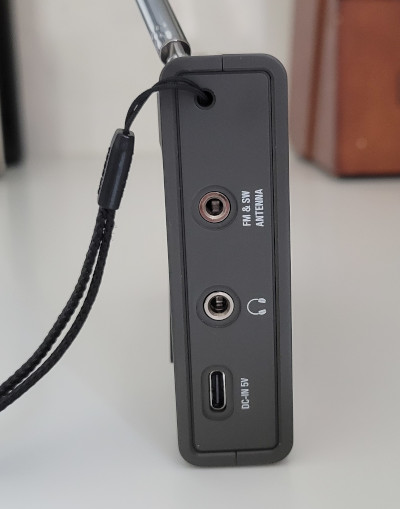
While the PL-320 has a lithium-ion battery just like the PL-330, its charging port is a fully modern USB-C jack (left), possibly a first for Tecsun. (The PL-330 uses a USB micro connection for charging.)
There's also a jack for an external antenna for FM and shortwave reception. There's also an undocumented setting that allows the same jack to be used for AM reception. I describe this and other settings in more detail in Tecsun PL-320 Settings and Features.
For AM listeners, the PL-320 offers four audio bandwidth filter settings: 2.5, 3.5, 5, and 9 kHz. You toggle among them by pressing a dedicated button, labeled with a graphic intended to suggest multiple bandwidths. It's to the left of the key used to switch to MW/LW (mediumwave [AM}/longwave) reception. Narrower bandwidth filtering allows for better selectivity at the expense of audio fidelity. If you can find an AM station that plays music these days, you'll find that there's a difference between the 5 and 9 kHz settings that's noticeable. Music on AM can sound much better on the PL-320 compared to many other AM radios. For everyday use, I tend to land on either 3.5 or 5 kHz as a reasonable balance between selectivity and audio fidelity.
Some additional testing causes me to believe that the "9 kHz" bandwidth setting really isn't 9 kHz. I've used sweep tones and audio samples to estimate that the actual bandwidth is around 7.5 kHz.
DXers, hobbyists who chase difficult and distant signals, were dismayed when the PL-330 offered only three AM bandwidth filters: 2.5, 3.5, and 9 kHz. A review from noted DXer Gary DeBock points out that a very narrow bandwidth filter, such as 1 kHz, is needed for DXing stations that are close to strong local signals. In this regard, the PL-320 still doesn't offer the capability that DXers are looking for, but it does offer a better set of choices for ordinary listening. The first generation of Tecsun models, which offer up to five bandwidth filters -- 6, 4, 3, 2, and 1 kHz -- may better meet DXers' needs, at the possible expense of more interference generated by the radio itself due to inadequate internal filtering of noises from the internal digital circuitry.
The PL-320 also has extensive memory functions, including:
- Auto Tuning Storage (ATS) - to assign memories automatically.
- A "Favourite Station" button for instant access to a preferred station.
- Two memories (for two alarms) to set the station that will turn on at a preset time. These are shown on the radio as "timers" but they are really alarms.
- Easy Tuning Mode Plus (ETM+) - with a twist on AM and shortwave. There are different sets of ETM memories on those bands for different times of day to take advantage of different reception conditions at different times of day. This isn't needed on FM.
As a consequence of ETM+, the Easy Tuning Mode is more complex than it is on earlier Tecsun models. It's a feature that requires a careful reading of the user manual in order to use it effectively. Except on FM, it's not as easy as it might first appear!
ATS and ETM+ differ in other ways, since ATS is just an automated way of using standard memory in what Tecsun calls "View Memory" (VM) mode.
- ETM memories can't be addressed directly by number, ATS-assigned memories are just standard memory and can be addressed via the numeric keypad in VM mode.
- ETM will pick up many more signals than ATS. As an example, at my San Francisco Bay Area location, I picked up 27 to 29 stations when triggering ATS while ETM picked up 55 signals, a few of which weren't real signals. In other words, the threshold for detection is much lower for ETM than ATS. ATS memories can also be supplemented by manually assigning stations to memory slots.
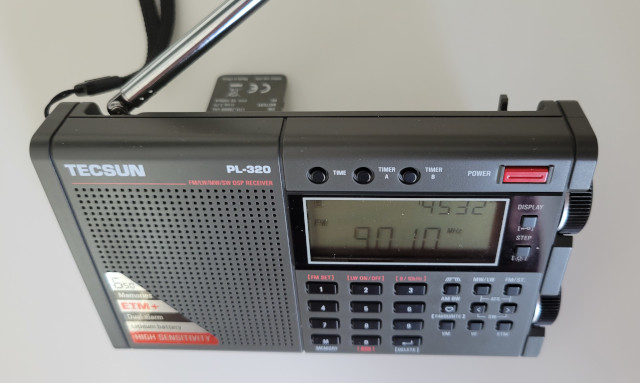
Another nice feature of the PL-320 is a built-in stand to prop up the radio (left). Earlier Tecsun models also had stands, but they were pretty short. The PL-320's stand is longer and more practical for use. The PL-330 has no stand.
Compared to the earlier Tecsun DSP-based models, the PL-320 has a slightly more pleasant sound. It's not high fidelity by any means, but it's not as tinny as the sound from models such as the PL-310ET and PL-380. The speaker is slightly larger than that on the PL-380 but the same size as the PL-310ET: 1 7/8" or 48mm.
Unfortunately, if you're using the radio as an alarm clock, there is a minimum sound level for the alarm. That level is louder than what I prefer for routine listening. This is very jarring on earlier Tecsun models. The PL-320 mitigates this effect somewhat. Whenever it turns on, the volume ramps up gradually but quickly. Likewise, when turning it off, the radio ramps down the volume. This feature makes the radio seem more refined than earlier models.
Stereo audio is available only at the headphone jack when listening to FM stations. Stereo reception can be toggled on or off by pressing the FM/ST button while listening to FM. The default is for stereo reception to be on. Audio quality is good. There's no line-out jack, but I don't know of a Tecsun model that offers such a feature. Since there are no tone controls, recording from the headphone jack is just a matter of making sure audio output is set at a useful level.
Performance
How does the PL-320 perform? I made head-to-head comparisons with earlier Tecsun models and with the C. Crane Skywave. I believe that the PL-320 is a direct competitor with the C. Crane model (the one that doesn't have SSB). Please note that reception conditions can vary from day to day. There will also be changes in the number of stations on the air, particular on AM. So counts may vary from earlier reviews of the radios being compared. When doing these comparisons, it's important to do them at approximately the same time on the same day.
| Model | AM | FM |
|---|---|---|
| (Available stations) | 48 | 55 |
| Tecsun PL-320 | 48 | 52 | CC Skywave | 43 | 52 |
| Tecsun PL-310ET | 43 | 54 |
| Tecsun PL-380 | 42 | 55 |
AM reception was tested outdoors due to severe interference inside my house in Oakland, possibly due to solar panels and their associated circuitry on the roof. These numbers don't tell the whole story, at least on FM. I also checked to see how many FM stations could be received in stereo. The results:
- Tecsun PL-320: 34 stations in stereo
- C. Crane Skywave: 33 stations in stereo
- Tecsun PL-310ET: 30 stations in stereo
- Tecsun PL-380: 28 stations in stereo
All four models had only minor differences in FM performance, though it seemed that the PL-380 could get stronger audio from a weak signal than any of the others. But the PL-320 did the best at getting a stereo signal out of signals that had only fair signal strength. (This seems to be a better outcome for FM reception than the PL-330, judging by reviews such as the one at Dave's Radio Receiver Page.)
It also appeared that the PL-320 had a stereo blend function for weaker FM stereo signals, thereby reducing stereo separation in order to reduce noise, but it wasn't noticeable on most stations.
On a different day, I also did a head-to-head comparison with the Digitech AR-1780 (the XHDATA D-808 is the same radio, just with a different battery configuration). The results were identical: 47 signals picked up, of which I considered 43 to be at least marginally listenable. I used the 4 kHz bandwidth filter on the Digitech and the 5 kHz filter on the Tecsun.
In 2024, after moving to Colorado and after acquiring a Qodosen DX-286 receiver, I did more performance comparisons using a scoring methodology to evaluate performance, rather than just tallying station counts. I found that the PL-320 was an excellent performer on both AM and FM, though the Qodosen was just a little better on FM and had multiple bandwidth options for FM that the PL-320 lacked.
The automatic gain control on the Digitech was more refined than that on the Tecsun model. When tuning to a vacant or near-vacant channel, the AGC on the Tecsun tends to bring up the noise floor for about the first half second or so before it settles down. The Tecsun AGC also seems to be more aggressive. Both radios have very good audio recovery from all but weak signals. In any event, this outcome was a surprise. I was expecting that the Digitech would be the stronger performer, due to a larger size and larger internal antenna. Instead, they were just about equal, though the Digitech seemed to have less noise and was a little more pleasant to use.
I should also note that there were still a few noises on the Digitech generated by its internal circuitry whenever buttons were pressed. Otherwise it was free from such noises. The Tecsun PL-320 was free of almost all such noises, even when buttons were pressed.
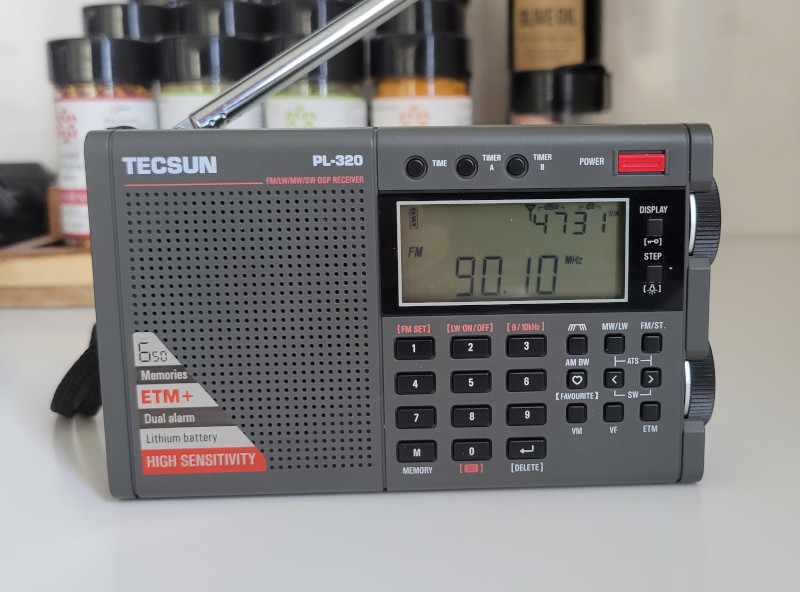
Conclusion
The Tecsun PL-320 offered a lot of pleasant surprises. My least favorite thing about this model is the lithium-ion battery. At least it's a BL-5C battery, which I have found to be reliable and stable in other units. USB-C charging is fast. When charging, the radio's display becomes a stopwatch, indicating the time it's taking the battery to charge. When the battery is charged, the display stops and shows the amount of time it took to charge the battery. This display stays active until the USB-C charging cord is unplugged.
I also wish setting an alarm were simpler, not requiring storage of a specific station ahead of time, and not requiring a minimum volume level when the alarm goes off.
But Tecsun got a lot of other things right with this model. There's a lot of flexibility, the controls are good (if a little small for certain functions), speaker sound is a little better than most other Tecsun models, and reception performance is very good or excellent.
I'm afraid the PL-320 will be overshadowed by the PL-330 because the two models look so much alike, but I think the PL-320 is a model worth considering on its own merits. It's more than just the PL-330 minus SSB. While it took Tecsun some time to catch up with its competitors in recent years, it finally did so in 2023, producing a radio that's enjoyable and very likeable even with the use of a lithium-ion battery. Just be sure to read the user manual to get the most out of this radio.
More on the Tecsun PL-320
» Comparing performance of the PL-320 with similar radios (new in 2024)
» Also see: Tecsun PL-330 feature reference sheet - some PL-320 functions are similar to those on the PL-330
» Also related to the PL-330: Review at Dave's Radio Receiver Page - Note that the PL-320 will be different in some aspects